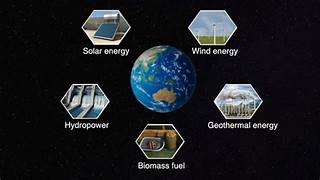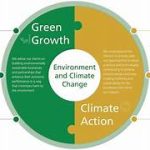Renewable Energy Sources and Their Effects
In recent decades, the world has witnessed a growing shift toward renewable energy sources, largely driven by the imperative to mitigate climate change, reduce environmental degradation, and create sustainable energy systems. Renewable energy, derived from natural resources such as sunlight, wind, and water, presents a clean alternative to fossil fuels, which have been the cornerstone of global energy systems for over a century. With concerns about the harmful environmental impacts of coal, oil, and gas burning—ranging from greenhouse gas emissions to air and water pollution—renewable energy has become a crucial element in the global effort to transition to a more sustainable and eco-friendly future. However, like any significant technological and societal shift, the widespread adoption of renewable energy comes with its own set of challenges, including its effects on the environment, economy, and society.
This article explores the various types of renewable energy sources, their benefits, and potential challenges, as well as their overall effects on the environment, economy, and the global energy landscape.
What Are Renewable Energy Sources?
Renewable energy refers to power generated from resources that are naturally replenished on a human timescale, such as sunlight, wind, water, and geothermal heat. Unlike fossil fuels, these resources do not deplete over time, making them sustainable for long-term use. The most common renewable energy sources include:
1. Solar Energy
Solar energy harnesses the power of the sun through photovoltaic (PV) cells or concentrated solar power (CSP) systems. Solar PV cells convert sunlight directly into electricity, while CSP systems use mirrors or lenses to focus sunlight and generate heat, which is then used to produce electricity.
2. Wind Energy
Wind energy is captured through wind turbines that convert the kinetic energy of moving air into electricity. Wind farms—both onshore and offshore—are increasingly common, with countries such as Denmark, the United States, and China leading the charge in wind power production.
3. Hydropower
Hydropower, or hydroelectric power, is generated by using water flow, typically from rivers or dams, to turn turbines and generate electricity. It is one of the oldest and most widely used renewable energy sources, providing a significant portion of global electricity, particularly in countries with abundant water resources.
4. Geothermal Energy
Geothermal energy is derived from the heat stored beneath the Earth’s surface. This energy can be harnessed by tapping into hot springs, geysers, or other geothermal reservoirs to produce electricity or provide heating for buildings.
5. Biomass Energy
Biomass energy is produced from organic materials such as wood, agricultural residues, and animal waste. When burned or processed, these materials release energy that can be used for heating, electricity generation, and even transportation fuels (biofuels).
The Benefits of Renewable Energy Sources
The shift to renewable energy offers numerous advantages, particularly when compared to traditional fossil fuels. Here are some of the key benefits:
1. Environmental Impact Reduction
One of the most significant advantages of renewable energy is its minimal impact on the environment. Unlike coal, oil, and natural gas, which release harmful pollutants and greenhouse gases into the atmosphere, renewable energy systems generate little to no emissions during their operation. Solar, wind, and hydroelectric systems produce clean energy without polluting the air or water, making them crucial in the fight against climate change.
- Lower Greenhouse Gas Emissions: The burning of fossil fuels releases carbon dioxide (CO2), methane (CH4), and nitrous oxide (N2O) into the atmosphere, contributing to global warming. Renewable energy, on the other hand, has negligible emissions and helps reduce the overall carbon footprint.
- Air and Water Quality: Traditional fossil fuel extraction and combustion processes can contaminate air and water. In contrast, renewable energy generation typically uses fewer resources and has little negative effect on water and air quality.
2. Sustainable Energy Supply
Renewable energy is inexhaustible. Unlike fossil fuels, which take millions of years to form and are being depleted at unsustainable rates, renewable energy sources are naturally replenished. The sun will continue to shine, the wind will keep blowing, and the Earth will retain its heat for the foreseeable future. This sustainability makes renewables a key component of a long-term, resilient energy strategy.
3. Energy Independence and Security
Renewable energy can help reduce dependency on foreign oil and gas, which often come with geopolitical challenges and price volatility. By investing in renewable energy infrastructure, countries can secure their energy supply, lower their vulnerability to energy price fluctuations, and enhance national security. For example, countries with abundant sunlight and wind could significantly reduce their reliance on imported energy.
4. Economic Growth and Job Creation
The renewable energy sector is also a major driver of economic growth. The transition to a greener economy requires significant investments in new technologies, infrastructure, and maintenance, all of which create job opportunities. Solar and wind industries, in particular, have seen substantial job growth in recent years. The International Renewable Energy Agency (IRENA) estimates that by 2050, the renewable energy sector could provide up to 85 million jobs globally.
Challenges and Potential Negative Effects of Renewable Energy
While renewable energy offers numerous benefits, there are also challenges and potential negative effects that must be considered. Some of these issues include:
1. Intermittency and Reliability
One of the main challenges associated with renewable energy is its intermittency. Solar energy is only available when the sun shines, and wind energy is dependent on the presence of wind. This makes it difficult to rely entirely on renewables without the risk of energy shortages, especially during times of high demand or unfavorable weather conditions.
To address this issue, energy storage technologies, such as batteries, are being developed to store excess energy generated during periods of high production for use when demand is high or when renewable sources are not available. However, these storage technologies are still evolving, and their widespread use could require further investment.
2. Land Use and Habitat Disruption
While renewable energy sources have a smaller environmental footprint compared to fossil fuels, they are not entirely without impact. For example, large-scale solar farms and wind farms require significant amounts of land, which can disrupt natural habitats and local ecosystems. Hydropower projects, such as dams, can also lead to deforestation, displacement of communities, and changes to water ecosystems.
Careful planning and site selection are critical to minimizing the negative environmental impacts of renewable energy installations. In some cases, placing solar panels on rooftops or utilizing offshore wind farms can help reduce land use conflicts.
3. Cost and Initial Investment
The transition to renewable energy requires significant upfront investment in infrastructure, including solar panels, wind turbines, energy storage systems, and grid modernization. While renewable energy systems are often cheaper to operate and maintain than fossil fuel plants, the initial capital costs can be high, especially for developing countries. However, the long-term benefits, including reduced fuel costs and environmental savings, often outweigh these initial expenses.
4. Resource Availability and Geographical Limitations
Not all regions of the world are equally suited for renewable energy production. For example, countries with limited sunlight or wind may struggle to generate sufficient energy from solar or wind sources alone. In such cases, a mix of renewable energy technologies, including hydro, geothermal, and biomass, might be required to ensure a reliable energy supply.
The Future of Renewable Energy: A Path Toward Global Sustainability
Despite the challenges, the future of renewable energy looks promising. Technological advancements, such as improved battery storage, more efficient turbines, and next-generation solar panels, continue to make renewable energy more accessible and cost-effective. In addition, the growing urgency of addressing climate change and reducing greenhouse gas emissions is spurring both governments and private sectors to invest heavily in green energy solutions.
The path to a fully renewable energy-dependent world will require collaboration across industries, governments, and communities. Policies that promote research and development, incentivize clean energy investments, and facilitate grid integration will be essential to achieving widespread renewable energy adoption.
As renewable energy technologies continue to mature and their benefits become more apparent, it is likely that we will see a significant global shift toward sustainable, low-carbon energy systems. This transition, while challenging, offers an opportunity to create a cleaner, more resilient, and equitable energy future for generations to come.
Conclusion
Renewable energy sources offer a promising path toward a more sustainable, eco-friendly, and energy-secure world. While there are challenges related to intermittency, land use, and cost, the long-term benefits—reduced environmental impact, energy independence, and job creation—make the transition to renewables essential for future generations. With continued technological innovation and global cooperation, renewable energy could very well become the cornerstone of the world’s energy systems in the coming decades.


